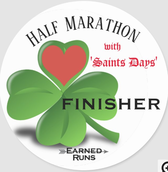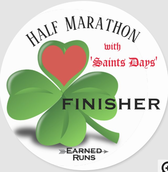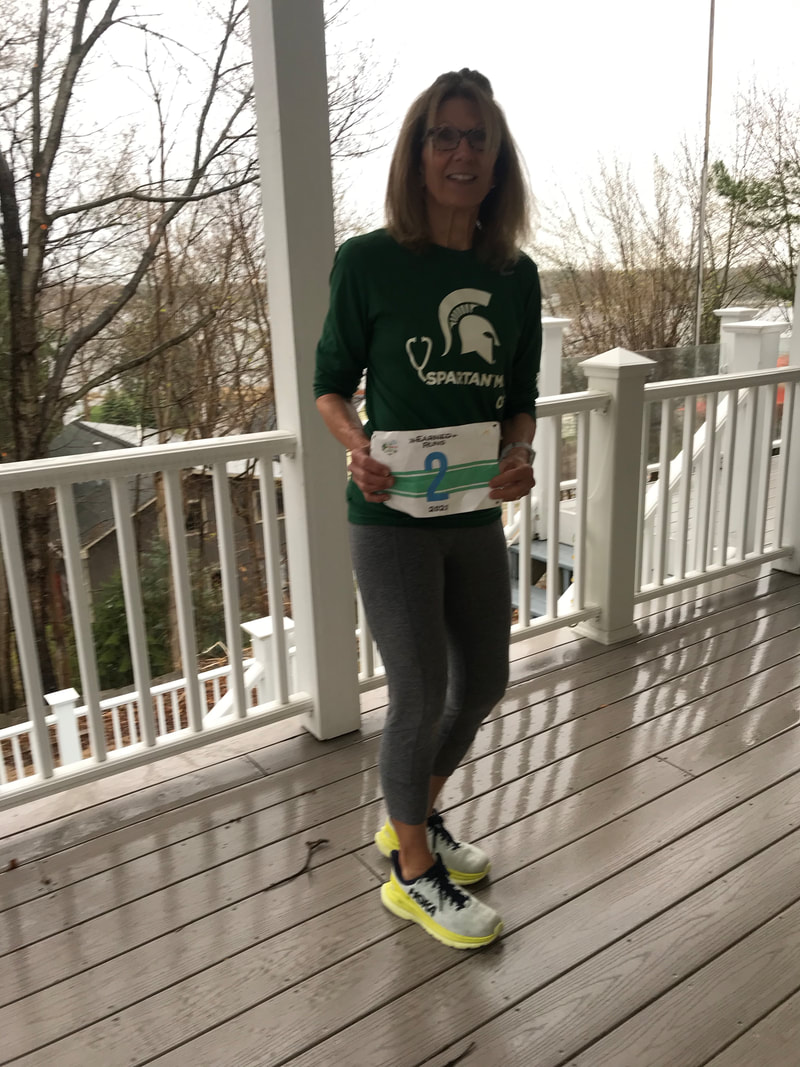BLOG
|
 WEEKS 14-15 Runners, finally, on the last day of Week 14 training you proved you have what it takes to run 13 miles! But you’ll run it easy, with stops as needed. Walkers, you did it at the end of Week 15. Both groups are essentially ready to go the distance in competition now. These plans extend for 18 rather than 16 weeks to allow safe preparation, include a generous taper, and provide a little wiggle room to allow for minor training setbacks or other circumstances that prevent continuous training according to plan. The Earned Runs programs initial intention was to bring runners and walkers to their organized half marathon events’ starting lines in late April through mid-May. However, because of COVID-19 pandemic precautions continuing from 2020 into 2021, many half marathons are likely to again be postponed, cancelled, or converted to virtual format. There may be no need to taper through week 17 or 18! The taper is built into the schedule to help prevent injury and to boost performance under actual race conditions. If your race is personal or aimed at achieving a ‘soft’ record, there’s no reason to put it off. On the third Monday in April, the 19th of 2021, we should have been able to enjoy TV coverage of the 125th Boston Marathon. [It has again been re-scheduled in the fall and will take place on October 11.] Earned Runs usually advises runners to watch TV coverage and take note of the leaders’ running forms. Their heads would have been up, chests out, torsos tall and erect, shoulders loose and down, with elbows rhythmically pulled back. If it was possible to count the number of steps taken per 15 seconds (multiply by 4 to get steps/minute) to calculate cadence, you might have counted a number greater than 180, possibly up to 200. You would have had a chance to compare your form with that of the elites. When I had been advised to do this by a trainer to correct my form, I scoffed at the idea. I wasn’t an elite, was my thinking, so why run like one? I am a plodder, with a pace about 2.5 times greater than the best in the world. It would be pretentious! But I followed the advice and started to check out running form on all images, including magazine covers, ads, and online articles. All the pros displayed similar form. Athletes who dedicate their efforts 24/7 to being the best runners in the world and building professional running careers that span decades don’t adopt a certain form to look pretty in pictures; they do it to be fast and prevent sidelining injuries. I wanted to be fast and avoid injuries too, so tried to model my form on that of the elites, just like Coach instructed. There are other components to good form running. See the chart from New Balance on the RESOURCES page to refresh your memory. The secret to maintaining it throughout a long run is to build core, upper body, hip, leg and strength in training. The form for walking fast, but not race walking, is somewhat similar. I find that the greatest source of fatigue at the end of 13.1 miles comes from having a tired back, core, and arms. Which means there’s more work to do to become stronger in these areas. An additional benefit is that this work will translate into a more athletic posture. Those who counted on competing in an organized long-distance event, now postponed or cancelled, have been given extra time to work on strength, posture, and form. Summer and fall will hopefully bring an end to COVID-19 confinement, and perhaps we all will be stronger and better prepared to experience the joy of competing. Congratulations on finishing 13 miles! WEEK 16 There’s not much to do this week, as you are on the glide path to your half marathon race. Don’t overdo the long run at the end of the week. You want to be prepared and fresh for the race. An extra foam rolling session is scheduled next week for runners and walkers, but either/both can add extra sessions anytime. It can be a full or an abbreviated session. Use it to roll out sore and stiff spots any day of the week. If you are tempted to introduce new nutrition, shoes, gear, or apparel into your race preparations, be careful. Most experts would advise against making changes. There isn’t much time to truly test a new fuel strategy. Also, the runs/walks are not as demanding as earlier in the plan and can’t serve as adequate trials of new food or gear items for use on race day. New spring fashion upgrades can serve as zero-calorie rewards for following through on your commitment to train and finish a goal race! Enjoy them AFTER crossing the finish line. If you have not yet found an organized virtual race to run or walk, or plans have collapsed, consider pinning on an Earned Runs bib to be sure you meet the challenge of running or walking the half marathon for which you trained. Don’t let circumstances deter you from reaching your goal race! Request a set of bibs today to keep one in reserve, “just in case”. RUN & MOVE HAPPY! https://www.runnersworld.com/advanced/a20811880/soft-records/ https://www.baa.org/races/boston-marathon
2 Comments
 WEEK 12: Runners and walkers, your long-distance workout extended into double digits last week (week 12), and next two-three long runs will build to a peak at week 14 for runners and week 15 for walkers when you will cover the longest distances of your training plans Can you believe yourself? Wow! This calls for a celebration - AND A FOAM ROLL. You might consider performing an abbreviated foam rolling session on the areas that tend to bother you BEFORE running or walking, and a full session afterward. You can foam roll the next day as well, if still feeling a bit sore. The bit of advice about pre-run foam rolling was provided by a trainer who at the time, was coaching a championship high school cross country team. Tim Broe now heads training at Saucony™ shoes company's Freedom Track Club, which is dedicated to developing Olympic running hopefuls. Pre-session foam rolling is not a practice prescribed only for oldsters or newbies. Congratulations for all the progress made this far. WEEK 13: Runners: your long run this week is the distance that some half marathon plans stop: 12 miles. Walker plans often stop at 10 miles. Both Earned Runs plans have you going farther. The why of this training tactic requires the telling of a bit of personal history. Because of a sudden change in late September 2012 weather that brought dangerous conditions including downpours of cold rain, showers of hail, thunder, lightning, and high winds, officials closed the very first half marathon in which I participated. The decision had been made mid-race for me, which meant the fleetest of the lead group were nearing the finish line and shelter of the gathering space church auditorium. I found myself being encouraged by race personnel to stop and leave the course, roughly at the 6.5-mile mark, the farthest possible point from my car, safety, and warm dry clothes. I was determined to finish, not to call for help and a ride. In spite of beautiful and mild weather conditions pre-race, I had had a tiny fear that I might not make it to the finish line. My confidence received a small boost upon overhearing other first-time half marathoners, next to me in the starting chute, worry about their training. They had covered 12 miles on their longest training run, as instructed by a trainer but weren't sure of that last 1.1 miles. I had accomplished the exact distance, 13.1 miles and then tapered 2 weeks. I didn’t ever learn their finish time or in what physical condition they were at the race’s end, or whether the 12-mile prep strategy worked for them in such terrible weather. However, I felt that my resolve to push through to the cold, wet finish had been cemented by that 13.1- mile training experience. I had done it before and could do it again, I knew. Unfortunately, official times weren't recorded for me or any other finishers after the race was called. But the ordeal was so memorable for everyone involved that in addition to the official half marathon race shirt the next year, an additional ‘survivor’ t-shirt was also made available, marking that event. Indeed, we were proud survivors! Thus, the Earned Runs plans have runners and walkers reaching 13 miles and then tapering for a couple weeks. Those who wish to make it exactly 13.1 miles, for mental training, go for it! If your race date is a week earlier, shorten your taper by one week. So, you’ll keep on keeping on with the Earned Runs plans in order to hopefully acquire both mental and physical insurance that finishing your race is entirely possible, especially if the going gets tough on race day. RUN & MOVE HAPPY! See the RESOURCES page for FOAM ROLLING links, including "5 Minute Warm-up With A Foam Roller " by Shane Barnard for Under Armor's MyFitnessPal.com. http://blog.myfitnesspal.com/5-minute-warmup-foam-roller/ https://strengthrunning.com/2019/03/using-a-foam-roller/ |
BRIDGE TO PHYSICAL SELF
Running, walking, and fitness activities enable us to experience our physical selves in a world mostly accessed through use of fingers on a mobile device. AuthorEARNED RUNS is edited and authored by me, runner and founder. In 1978 I began participating in 10K road races before 5Ks were common. I've been a dietitian, practiced and taught clinical pathology, and been involved with research that utilized pathology. I am fascinated with understanding the origins of disease as well as health and longevity. Archives
November 2023
CategoriesNew! Search Box
Earned Runs is now searchable! Check it out...
|



 RSS Feed
RSS Feed